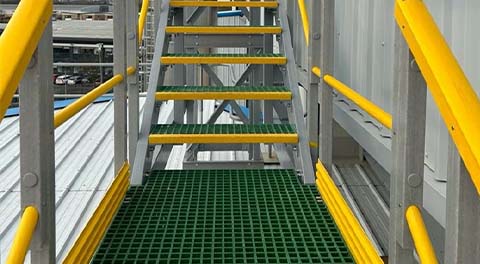loading...
- No. 9, Xingyuan South Street, Dongwaihuan Road, Zaoqiang County, Hengshui, Hebei, China
- admin@zjcomposites.com
- +86 15097380338
- Welcome to visit our website!
fibreglass grating price
Understanding the Pricing of Fiberglass Grating A Comprehensive Overview
Fiberglass grating, known for its durability, lightweight properties, and resistance to corrosive environments, has become a favored choice in various industries, including construction, manufacturing, and marine applications. However, when considering its integration into projects, one primary concern for stakeholders is the pricing of fiberglass grating. This article aims to explore the factors influencing fiberglass grating prices, the advantages it offers, and how to make informed purchasing decisions.
What is Fiberglass Grating?
Fiberglass grating is manufactured by combining fiberglass with resin to create a strong, lightweight material. It features an open grid design, providing excellent drainage and ventilation while being slip-resistant and robust enough to bear heavy loads. This type of grating is commonly used in walkways, bridges, industrial flooring, and even decorative applications in residential settings.
Factors Affecting Fiberglass Grating Prices
1. Material Type The price of fiberglass grating can vary depending on the type of resin used. There are several types of resins—polyester and vinyl ester being the most common. Polyester resin is generally less expensive, while vinyl ester, known for its added strength and chemical resistance, tends to cost more.
2. Manufacturing Process The fabrication method significantly impacts the final cost. Molded fiberglass grating, which is produced by pouring liquid resin into a mold, is typically more affordable. In contrast, pultruded grating, made by pulling fiberglass through a resin bath and then curing it, is often more costly but offers enhanced structural strength.
3. Load Capacity and Thickness The load-bearing capacity required for the installation affects the price, as thicker grates are generally more expensive. Projects needing higher load capacities may necessitate special engineering and custom designs, which can further elevate costs.
4. Customization and Design Custom shapes, sizes, and colors will influence pricing. While standard grating is widely available at lower costs, bespoke designs tailored to specific project needs may require additional production time and resources, leading to higher prices.
5. Market Demand and Supply Chain Factors Just like any other commodity, market demand and supply chain dynamics play a crucial role in pricing. Any fluctuations in the availability of raw materials or changes in production capabilities can directly affect costs.
fibreglass grating price

6. Supplier and Quantity Buying in bulk often leads to quantity discounts. Pricing can vary significantly among suppliers based on their production methods, market positioning, and customer service offerings. Thus, researching multiple suppliers can help in obtaining a more competitive price.
Advantages of Fiberglass Grating
Despite variations in pricing, the benefits of fiberglass grating often justify the investment. These include
- Corrosion Resistance Fiberglass grating is impervious to chemicals and moisture, making it ideal for environments where metal grating would corrode. - Lightweight and Easy Handling Compared to steel grating, fiberglass is significantly lighter, making installation and transport more manageable. - Long Lifespan With proper maintenance, fiberglass grating can last for many years without degrading, reducing replacement costs over time. - Safety Features Many fiberglass gratings have anti-slip surfaces, making them safe options for areas where slip hazards exist.
Making Informed Purchasing Decisions
When considering the purchase of fiberglass grating, it is essential to evaluate not just the cost but also the long-term benefits it provides. Here are some tips for making informed choices
1. Assess Your Needs Determine the requirements of your project, including load-bearing capacity, environmental conditions, and any customization that may be necessary. 2. Request Quotes Reach out to multiple suppliers for quotes. Comparing prices will give you a broader perspective on what constitutes a fair price in your region.
3. Evaluate Supplier Reputation Ensure that the supplier you choose has a solid reputation for quality and customer service. Customer reviews and testimonials can be valuable resources.
4. Consider Total Cost of Ownership Beyond the initial purchase price, consider factors like installation costs, maintenance, and lifespan to assess the total cost of ownership.
In conclusion, while the price of fiberglass grating can vary widely based on multiple factors, it remains a worthy investment for many applications. By understanding the market, evaluating your specific needs, and choosing the right supplier, you can harness the benefits of fiberglass grating without breaking the bank.
-
GRP Structures: The Future of Lightweight, High-Performance EngineeringNewsJun.20,2025
-
FRP Water Tank: High-Performance Storage for Corrosive and Clean Water SystemsNewsJun.20,2025
-
FRP Square Tube: The New Industry Standard for Chemical and Structural ApplicationsNewsJun.20,2025
-
FRP Pultruded Profiles: The Ultimate Choice for Lightweight Structural StrengthNewsJun.20,2025
-
FRP Handrails: The Safer, Smarter, and Stronger Choice for Modern InfrastructureNewsJun.20,2025
-
FRP Grating: The Smart Solution for Durable, Lightweight Industrial FlooringNewsJun.20,2025
-
Why Choose a Galvanized Water Tank for Your Storage NeedsNewsMay.21,2025
